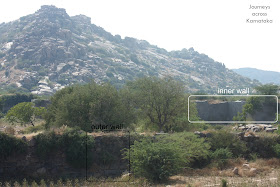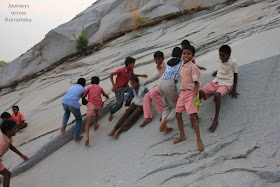After Manvi fort we headed back towards Raichur with a stop at Kallur to see Mahalaxmi temple and the historic Markandeshwara temple. Kallur is also prehistoric site but we did not know what to look for. Next on our itinerary for the day was Maliabad fort, 6 kms south of Raichur. I wanted to check for a shortcut to Maliabad but a local man suggested we go via Raichur because the interior roads were in terrible condition. From Raichur 3 kms on Mantralaya we took the right fork which lead to Maliabad village. When we asked for directions to the fort, folks would ask if we wanted to go to the Goshaala.. OK, so there's a Goshaala inside Maliabad fort.
The fort is close to the village; we could see the wall with cotton fields in the foreground and Maliabad hill in the background.
As we move closer to the fort entrance the inner wall comes into view. In this picture below, the outer wall is marked in black and inner wall in white.
A narrow dirt track lead us into a gap in the ruined outer walls and continued little further with Maliabad hill on our left. The path ended with a locked gate between massive inner fort walls. A very narrow gap in the wall was the only way to get past the gate.
This 20' wall is made of just 5 layers of stone blocks, amazing isn't it? And the stones are dressed to perfection, smooth surface offers no grip to anyone attempting to scale the wall.
Makes me wonder how the sculptors managed to match the edges so closely. What we see is just the outer layer.. behind this is another layer and then packed rubble. These walls are solid enough to withstand cannon firing.. I feel cannon balls will bounce off these walls.
So this is a cattle enclosure.. we could see a herd of cows and calves. These are Javaari Aakala ~ Zebu breed. We guessed that this Goshalla protect and preserve Javaari Akala only, no hybrid varieties allowed here. In the background is an unfinished part of the wall. Abandoned stone-breaking activity can be seen (inset).
A partially dressed granite block measuring 5' x 5' x 10' was one of the smallest here. Larger ones approximately 18' long.
The herd seems to be eagerly waiting for the gates to open. This enclosure is L-shaped in plan, so its my guess this might be one of the entrances to the inner fort.
As soon as the gates parted the herd rushed off.. so this is their grazing time. This place looked peaceful, plenty of trees and shade. To the left we could see a small white building.. a man was waving at us, calling us towards him.
This person who called us lives here, away from his home in Rajasthan, managing the operations of Go Rakshana Samiti. He is responsible for production of cow urine medicine. He tells us a bit about himself: He was a patient suffering from neurological disorder. His family spent huge amounts of money for medical treatment but his condition did not improve. Having lost hopes his family tried every possible medicine and some how they came across cow urine medicine. He believes he cow urine cured him. Now he wants to give a part of his life to help spread the benefits of cow urine. He showed us a booklet titles Cow Urine: Principles & Applications published by by Hare Krsna Rural Life. The booklet has a long list of diseases and conditions which can be cured or controlled by cow urine.
This reminds me of something when we had just moved to Bengaluru late 70s. Our house was situated in a new locality with few houses scattered around. Everyday few kids used to herd cows to graze in the vacant plots. One day I happened to see the kids collect handful of urine and drink ..I was zapped! I was ignorant of cow urine's medicinal properties. However, only the Javaari Aakala urine is considered beneficial, not the other breeds'.
Now we are at the distillery- earthen stoves, wood fuel, earthen pots of various shapes and sizes. The process seems simple but requires the right equipment and timing.
This seems like the pot which gives out the final product.
Earthen pots used for storage and wooden casks transporting to far away places. Right next to the distillery is one of the watch towers and in the background is the hill.
For retail market the medicine is packed in 250 ml plastic bottles- that made me wonder why use plastic to store an organic product? Low cost and safe to transport but the purpose of providing purely organic product gets defeated here.
Our host's living quarters is a single room arrangement. He cooks his own food and other basic needs. The blue text on the building reads: In memory of Late Madishetty Narasayya, donated by wife.
A lovely sculpture of Mahishamadhini found within the fort is placed close to the distillery.
We bid bye to our friend. It was almost noon, Sun was blazing fiercely. On the way our of the fort, Malatesh and I walked for some distance. We wished we had come here early morning, we could have explored the hill too. We found another L-shaped entrance in the inner fort. Here the granite blocks were larger than the ones we saw earlier. The top-most block is in excess of 20' in length. We realized there's a lot more to explore.. we have to plan another visit.
Maliabad fot coordinates: 16°8'59"N 77°21'26"E
.........





























































